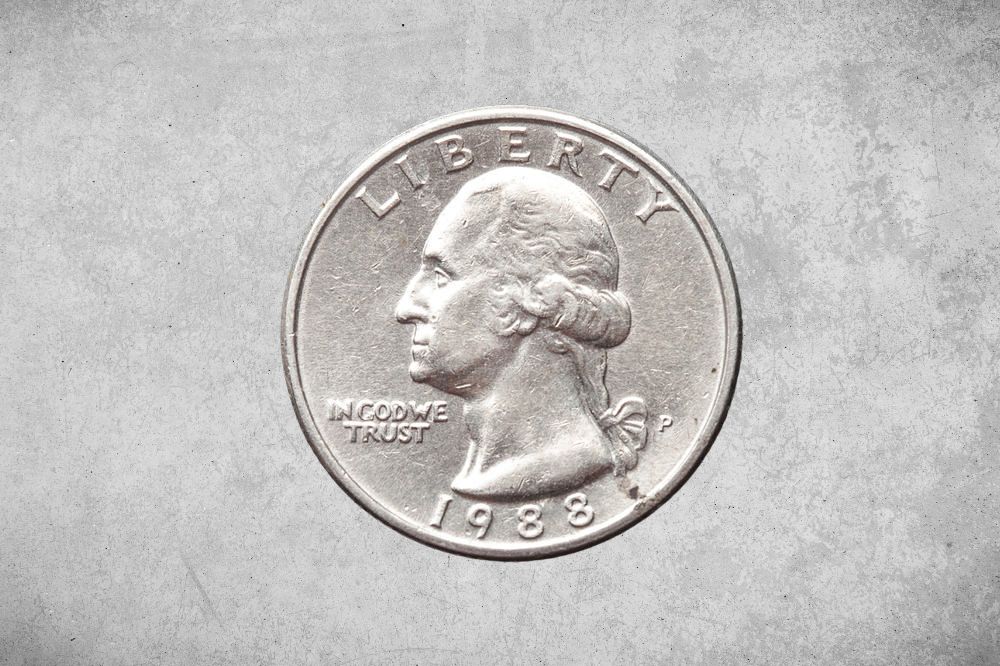The American Quarter is one of the most recognizable coins in existence. It features a signature portrait of George Washington and has undergone several redesigns recently, making it highly collectible.
The 1988 quarter is no exception, sporting the original designs by John Flanagan for a truly vintage piece. But given its substantial production numbers, coins are still commonly found in circulation today. Does that make the 1988 quarter worthless?
Not quite. Although the 1988 quarter might not seem valuable, some variations and errors can transform this small coin into something worth hundreds and sometimes thousands of dollars.
1988 Quarter Details
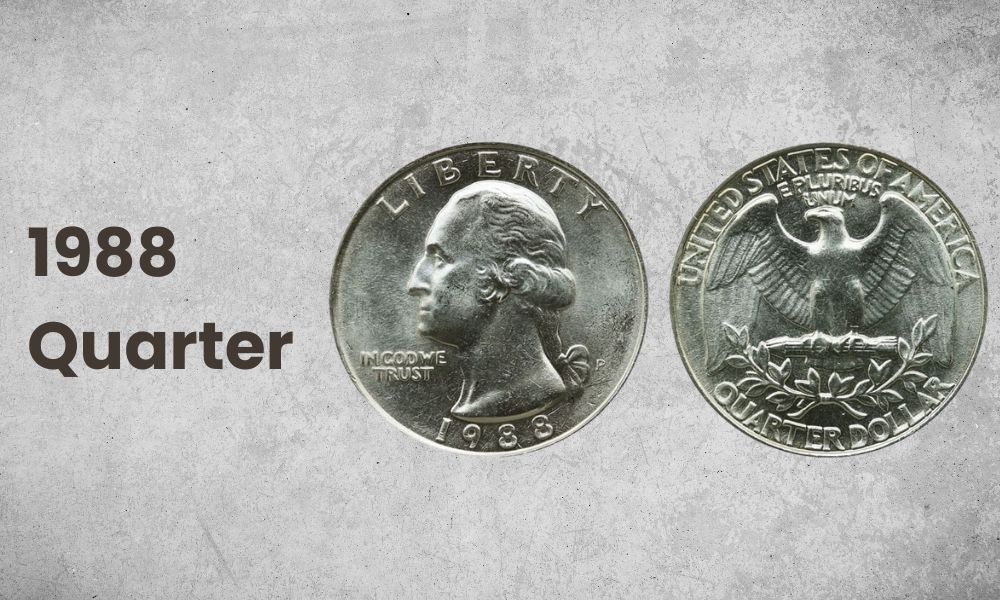
- Category: Washington quarter-dollar coin
- Mints: Philadelphia, Denver, San Francisco
- Total Mintage: 1,162,125,636
- Obverse designer: John Flanagan
- Reverse designer: John Flanagan
- Edge: Reeded
- Diameter: 3 mm
- Thickness: 75 mm
- Composition: Copper (91.67%), Nickel (8.33%)
- Weight: 67 grams
- Face Value: $0.25
The 1988 quarter is part of American history’s most famous coins series – the Washington quarter. With origins as far back as 1932, the quarter was used to help celebrate the bicentennial anniversary of US 1st president George Washington.
The 1988 coin is quite similar to make other years in the series and uses both the original obverse and reverse designs of John Flanagan.
The obverse side features a profile view of Washington, inspired by sculptor Jean-Anotiine Joudon’s bust of the president. The reverse, an eagle with open wings, was a design of Flanagan’s creation.
There are, however, some details that make the 1988 quarter unique to collectors. While the original series of quarters were fine silver, the 1988 quarter changed dramatically from this, being made mostly of copper and nickel. The reason for this is because of the evolution of the US economy through the years. In 1965, the rising cost of silver and coin production forced the US Mint to make quarters with cheaper but equally reliable materials.
As it was made using copper and nickel, the 1988 quarter weighs just 5.67 grams, considerably lighter than previous iterations. They still had the same diameter of 24mm, and thickness of 1.75mm, ensuring vending machines across the country could appropriately detect them.
A common feature of most quarters is their edging. The 1988 quarter has reeded edges, meaning it has narrow ridges throughout. This prevented people from “shaving” metal off the coin to be used to create counterfeits.
The 1988 quarter was minted in three locations across America; Denver, San Francisco, and Philadelphia. Every quarter had a specific mint mark stamped on for traceability. As an 80s coin, the 1988 quarters from Philadelphia were some of the first series to have the signature ‘P’ mint mark, which previously had been omitted.
With over 1 billion quarters produced in 1988, the coins have been widely circulated for decades. They may only be worth their face value at auction in good or fine condition. That said, a high-quality quarter can surprise you; some can sell for hundreds if not thousands of dollars.
Also Read: Top 16 Most Valuable Modern Quarters Worth Money
Value chart
1988 Quarter Value Chart |
||||
| Mint Mark | Good | Fine | Extremely Fine | Uncirculated |
| 1988 P Washington Quarter value | $0.25 | $0.25 | $0.25 | $17+ |
| 1988 D Washington Quarter value | $0.25 | $0.25 | $0.25 | $11+ |
| 1988 S Washington Quarter value | $0.25 | $0.25 | $0.25 | $4.63+ |
Because of their high production numbers, and relatively recent production, 1988 quarters aren’t deemed too valuable today. That said, unique errors, or high-quality conditioned coins, can still be worth vast amounts at auction.
Below is a quick guide to the four most common value categories:
- Good –the coin’s basic details, like date and type, are recognizable, but most details are worn or hard to read. This coin type is in very low demand.
- Fine – the coin is sharper and in slightly better condition but still has considerable wear and tear, especially on raised its raised surfaces.
- Extremely fine – the coin has great detail, especially around intricate areas like hair, but most can only be seen under a magnifying glass.
- Uncirculated – this coin may have feint signs of use, with little to no blemishes, and retains at least half its original sheen.
1988 Quarter Value and Varieties Guides
There are three different variations on 1988 quarters you can find. They are:
1988 P Washington Quarter value
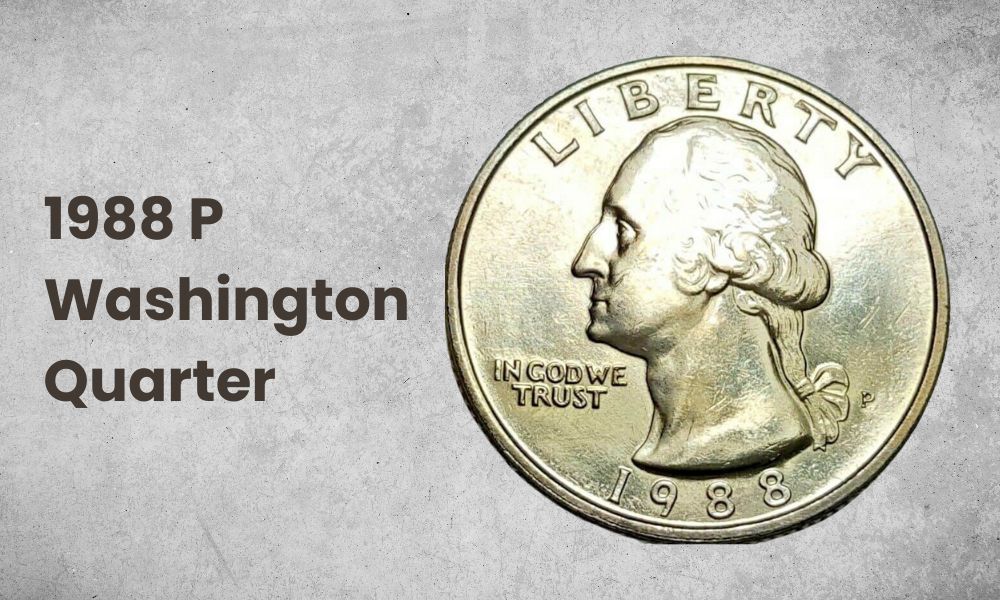
- Type: Washington series
- Edge: Reeded
- Mint mark: P
- Place of minting: Philadelphia
- Year of minting: 1988
- Face value: $0.25
- $ Price: $0.25 – $17+
- Quantity produced: 562,052,000
- Designer: John Flanagan
- Composition: Copper (91.67%), Nickel (8.33%)
- Mass: 67 grams
- Diameter:3 mm
Since the 1980s, Philadelphia marked coins with the signature letter ‘P.’ You can quickly identify if you have a coin from Philadelphia by examining the reverse side of your coin.
Because these were produced in their hundreds of millions, they are still seen as relatively common and have an average price value of face value (25 cents), to around $17 for high-quality coins.
But like any collectible, some exceptions have gone on to sell beyond expectations. This 1988 P quarter sold for an impressive $646 in 2017, showing you the potential these coins can have in the right circumstances.
1988 D Washington Quarter value
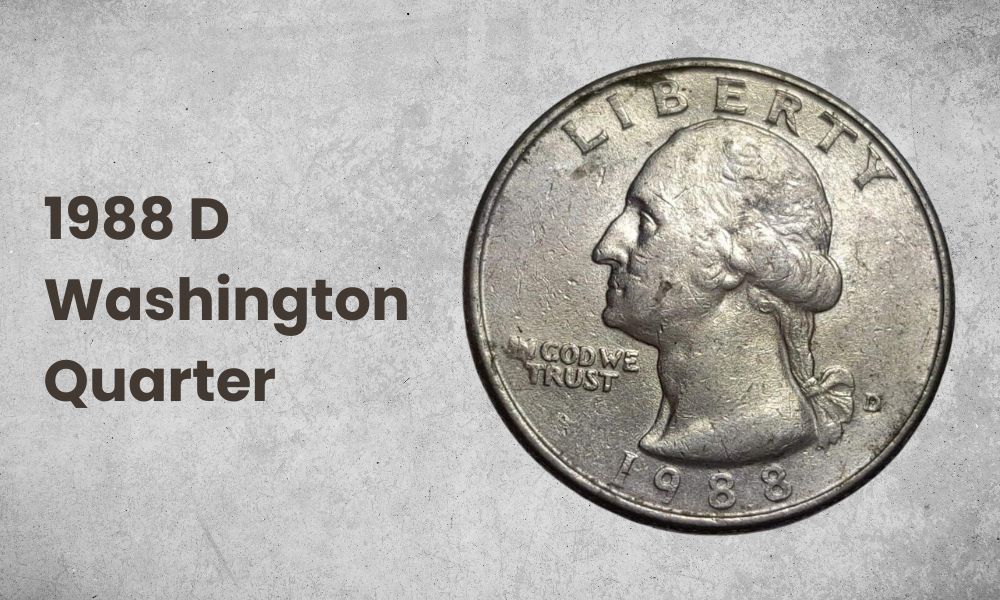
- Type: Washington series
- Edge: Reeded
- Mint mark: D
- Place of minting: Denver
- Year of minting: 1988
- Face value: $0.25
- $ Price: $0.25 – $11+
- Quantity produced: 596,810,688
- Designer: John Flanagan
- Composition: Copper (91.67%), Nickel (8.33%)
- Mass: 67 grams
- Diameter:3 mm
If you notice a small letter ‘D’ on the reverse of your 1988 quarter, that tells you it was minted in Denver. Denver produced the highest number in 1988 quarters, at almost 600 million. This makes them perhaps the most common type of quarter from this year.
As such, their value is generally lower than Philadelphia coins, ranging from a face value of 25 cents to about $11.
Certain 1988 D quarters have sold for impressive amounts at auction. For example, this 1988 D quarter sold for $660 in 2019 because of its high-quality luster and preservation.
1988 S Washington Quarter value
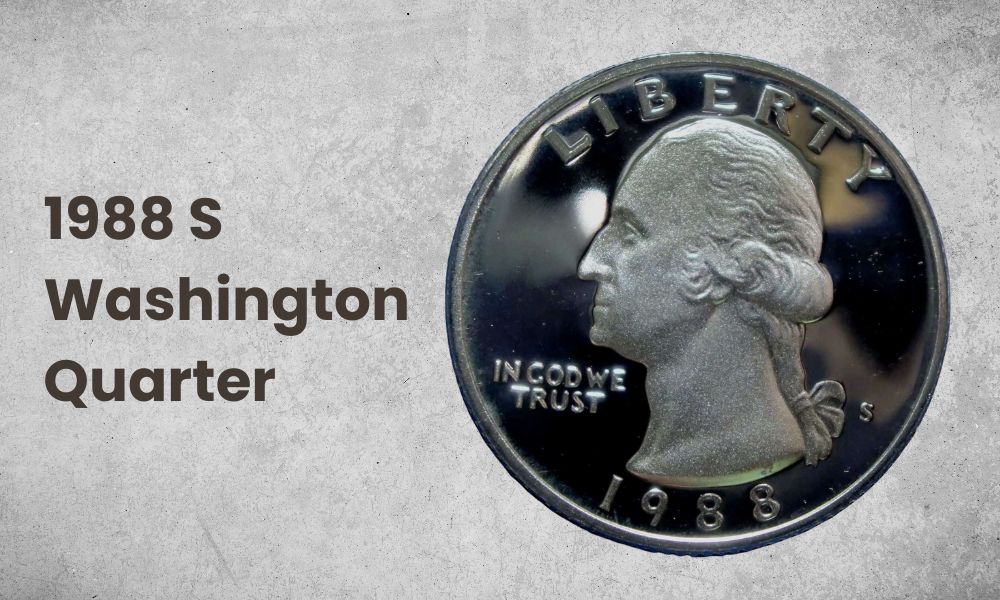
- Type: Washington series
- Edge: Reeded
- Mint mark: S
- Place of minting: San Francisco
- Year of minting: 1988
- Face value: $0.25
- $ Price: $0.25 – $4.63
- Quantity produced: 3,262,948
- Designer: John Flanagan
- Composition: Copper (91.67%), Nickel (8.33%)
- Mass: 67 grams
- Diameter:3 mm
The San Francisco proof is the third and final variation to the 1988 quarter. Easily identified by their signature ‘S’ mint mark, these coins were made as proofs, meaning they have high luster and mirror finishes to appeal to collectors of the series.
With only 3 million made, they aren’t that commonly found compared to other quarters. But on average, they still won’t go far beyond their face value of 25 cents, to about 5 dollars.
This may seem odd, given collectors usually love collecting proof coins, but 1988 S quarters aren’t that valuable in most cases. A potential reason for this is that 1988 is still relatively recent by today’s collector standards.
But don’t throw out your S quarters just yet! Some can still sell for a tidy sum at auction. This coin sold for $499 in 2013, proving demand for 1988 S quarters still exists. And with every passing year, these coins will surely increase in value.
1988 Quarter History
The Washington quarter is a coin series steeped in history. In 1932, the coin series was initially a temporary replacement for the half-dollar Walking Liberty. That is until Congress changed its plans and permanently replaced the Walking Liberty quarter.
The coin’s original design was by sculptor John Flanagan, who won an open competition to earn the honor. The only rule Flanagan had to follow was to use Jean-Anotiine Joudon’s bust of George Washington for the portrait.
The design showcases a profile view of George Washington with the words ‘Liberty’ and ‘In God, We Trust’ around him. The reverse was a simple eagle with its wings spread outward.
The initial design of the Washington quarter proved popular, as it tied in with the president’s bicentennial birthdate and America’s growing interest in the first president. The general public well-received the coin, and it has remained relatively unchanged in design until recently.
The initial quarter was composed of silver. But in 1965, because of rising production costs, the US Mint issued the Coinage Act, which reduced the amount of silver used. Both copper and nickel were ideal substitutes because they were cheaper, lighter, and hardy enough to last a long time in circulation.
As such, the 1988 quarter primarily comprises copper and nickel. It is much lighter than the previous series, weighing just 5.67 grams. It has reeded edges, common with higher-value coins like quarters, making counterfeiting the coin increasingly tricky.
There were three locations across America which made 1988 quarters. Philadelphia and Denver created the most coins, while San Francisco focused on producing a meager set of proof coins. Like other coins in the 80s, the Philadelphia quarter was among the first to sport the new ‘P’ mint mark, making it a highly collectible coin.
By today’s standards, the 1988 quarter is still relatively recent. And because of its exceedingly high production numbers, these coins are still circulating. As such, they aren’t as valuable as other issued dates. These coins will, on average, sell for just over their face value.
That said, these quarters will increase in value with every year that passes and can make an excellent investment for any potential collector.
Also Read: 10+ Rarest State Quarter Errors Lists (Worth Much Money!!!)
1988 quarter grading
So what affects the actual value and potential of a 1988 quarter?
Coins follow a set list of criteria to determine their uniqueness and condition. Factors include luster (sheen), level of detail, appearance, and if there are any noticeable errors present.
Below is a quick guide on how to grade your 1988 quarter:
List of 1988 Quarter Errors
Errors can make your generic 1988 quarter unique and increase its value tremendously. Below are some common mistakes you might find in the series:
1. 1988 Quarter on different coin types
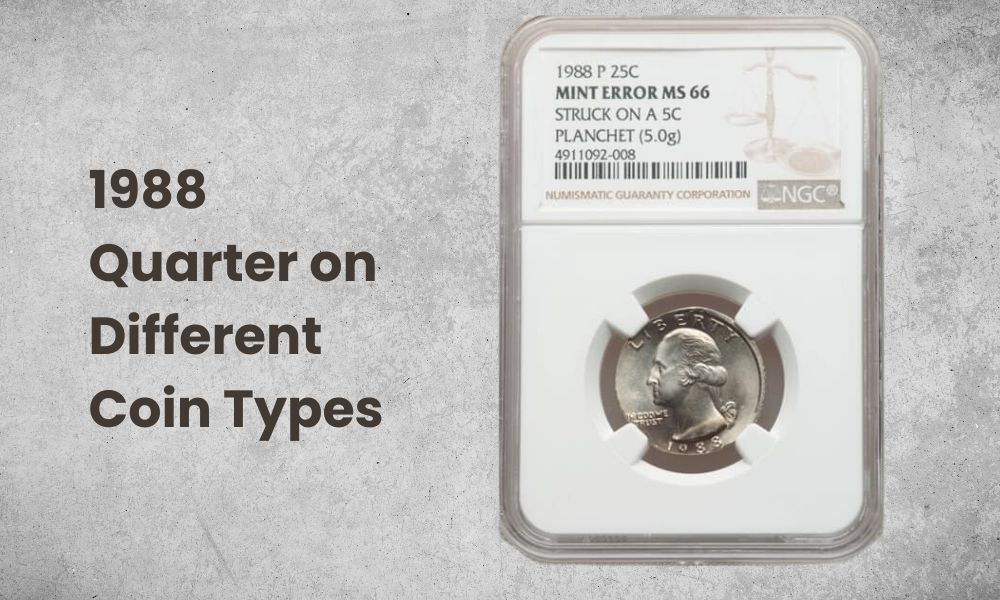
Because mints produce several different coins each year, the quarter’s design was frequently struck on the incorrect coin. This error can create exciting designs where part or all of Washington is missing from the coin.
This 1988 P quarter was struck on a 5-cent coin, producing a truly unique appearance, which ultimately sold for $852 in 2021.
2. 1988 Quarter with Off-Center Errors
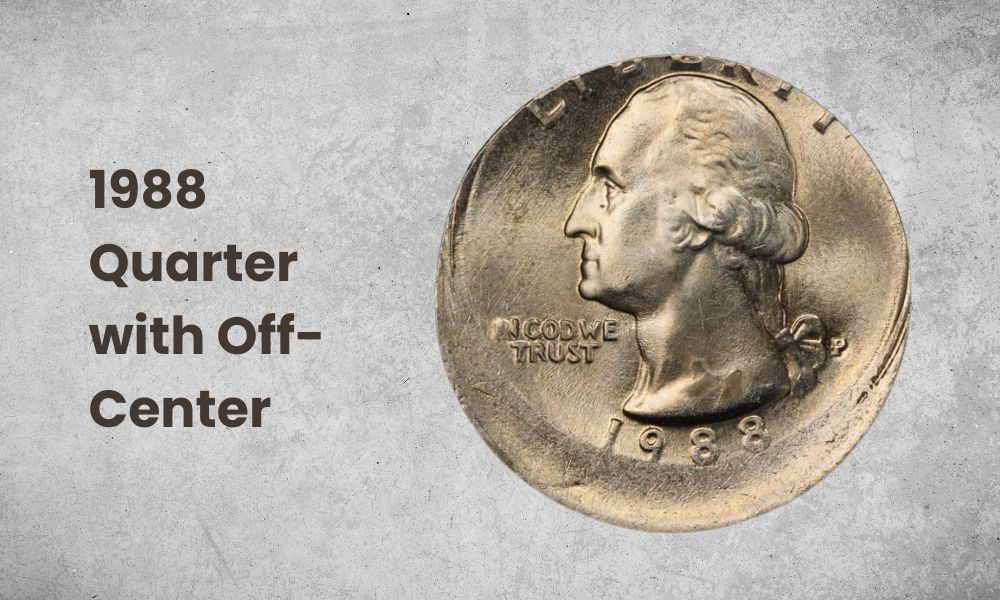
Off-center errors are common in coins, where the coin skews from the stamp, and the portrait sets at an angle.
While you might think this defect makes the coin worthless – the opposite is true. Off-center images usually increase the coin’s value, such as this 1988 P quarter with 15% off-centering, which sold for $55 in 2022. If the coin has a higher off-center, this can increase its value. For example, this coin with 30% off-center is worth a higher rate of $109.
3. 1988 Quarter with double strike error
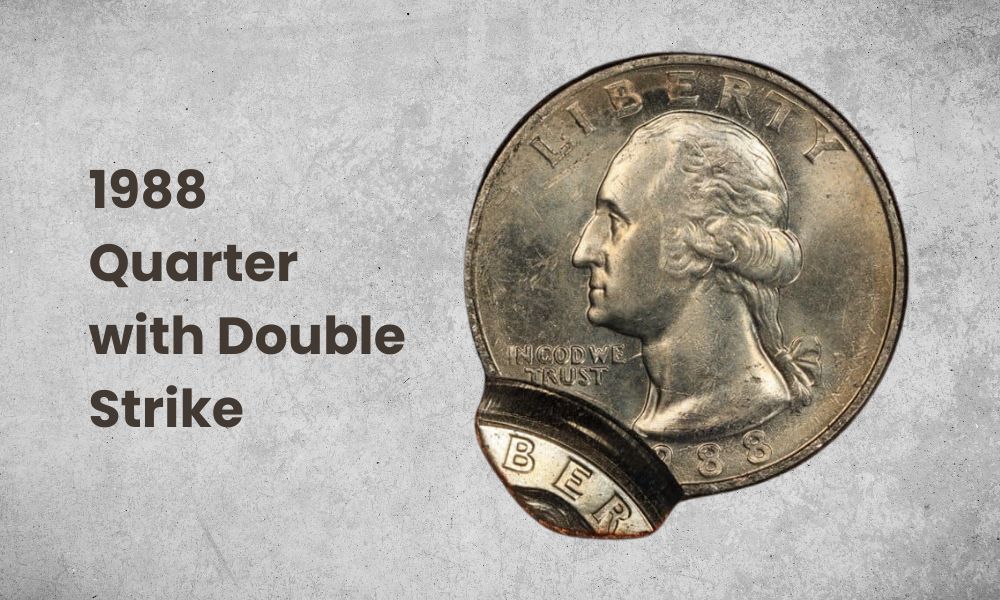
As the name suggests, this error is when the coin fails to eject from the striking chamber, and the minter strikes them twice. This error can create interesting patterns, such as pronounced detailing and repeated designs or distort the coin entirely.
The value of this type of coin depends on the severity and placement of the double strike, but it generally is worth a couple of hundred dollars at auction, like this 1988 quarter which sold for $204 in 2022; it has a double strike distortion with off-center designs.
1988 Quarter Value FAQ
What makes a 1988 Washington quarter rare?
Generally speaking, the 1988 quarter is still considered both recent and still in circulation. Demand for the coin isn’t that high. That said, a quarter can be considered rare if it is unspoiled.
Does a 1988 quarter contain any silver?
Unlike earlier versions of the Washington quarter, the 1988 quarter contains no silver.
How much is an average 1988 quarter worth?
The average 1988 quarter will be worth its face value of 25 cents. Because they are made primarily of copper, they have an even lower melting value of just $0.05.
